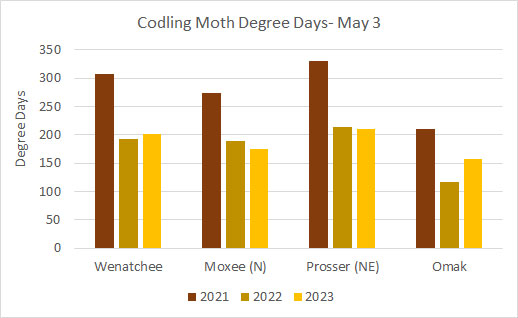Written by Liesl Oeller, Washington State University, May 3, 2023
Spring is here, and tree fruit pest management has begun. Below are updates on the codling moth, pear psylla, fire blight, and apple bloom models. For updates specific to your location, subscribe to DAS.
Codling Moth
Many areas in Washington and Oregon have reached 100 degree days, which means it’s time to set up codling moth mating disruption.
Codling moth mating disruption should be considered the foundation of any apple pest management program. When mating disruption products are applied before the first moths emerge, mating is reduced thereby limiting the number of codling moth eggs laid in the orchard. Fewer eggs laid means smaller populations that will need to be controlled with insecticides. Read more about how codling moth mating disruption works.
We’ve had a slow start to the codling moth model in 2023 compared to previous years (Fig 1). With the cool Spring we’ve had thus far, the codling moth model is just getting started in many areas (Fig 2).


Pear Psylla
Last month we held the 2023 pear psylla workshop, and thank you to all who attended! Dr. Robert Orpet from Washington State University gave a great talk on pear psylla phenology and management strategies. The DAS director Dr. Dave Crowder discussed the DAS pear psylla model and upcoming features to the platform.
For more updates on current pear psylla conditions, sign up for Pear Entomology Weekly. newsletters! Brought to you by WSU Tree Fruit researchers Robert Orpet and Molly Sayles, this newsletter has updates with weekly scouting data, degree days, and management guidelines. To subscribe, email robert.orpet@wsu.edu.
Apple Bloom
We’ve had a slow start to the codling moth model in 2023 compared to previous years (Fig 1). Another important model in early May are the apple bloom models. Apple bloom has been pushed back due to cool temperatures, and the Gala model is behind compared to previous years (Fig 3). In some locations, bloom is below 30% when in previous years apple bloom was complete.

Fire Blight
Sudden warm weather after weeks of cool temperatures has caused the risk of fire blight to spike. Any wetness event in the near future puts orchards at risk of fire blight infection. The total risk value (TRV) in many areas of Washington is well above the 350 TRV threshold for extreme infection risk in areas where fire blight occurred last year (Fig 4). If you are a DAS subscriber, you can check your station for specific risk values in your location. Note that weather conditions and TRV can change suddenly during tree fruit bloom, so check DAS regularly for updates. For more information on fire blight, visit the WSU Fire Blight Page and subscribe to the WSU Tree Fruit Extension newsletter. For any further questions on fire blight, contact Tianna DuPont, WSU Extension.
tianna.dupont@wsu.edu
(509) 713-5346

For weekly updates on DAS models and tools, subscribe to our mailing list! Now is the perfect time to subscribe to weather stations on DAS, get started today!
Contact
Liesl Oeller
Washington State University
Elisabeth.oeller@wsu.edu
(509) 335-5815
Fruit Matters articles may only be republished with prior author permission © Washington State University. Reprint articles with permission must include: Originally published by Washington State Tree Fruit Extension Fruit Matters at treefruit.wsu.edu and a link to the original article.
Use pesticides with care. Apply them only to plants, animals, or sites listed on the labels. When mixing and applying pesticides, follow all label precautions to protect yourself and others around you. It is a violation of the law to disregard label directions. If pesticides are spilled on skin or clothing, remove clothing and wash skin thoroughly. Store pesticides in their original containers and keep them out of the reach of children, pets, and livestock.
YOU ARE REQUIRED BY LAW TO FOLLOW THE LABEL. It is a legal document. Always read the label before using any pesticide. You, the grower, are responsible for safe pesticide use. Trade (brand) names are provided for your reference only. No discrimination is intended, and other pesticides with the same active ingredient may be suitable. No endorsement is implied.
